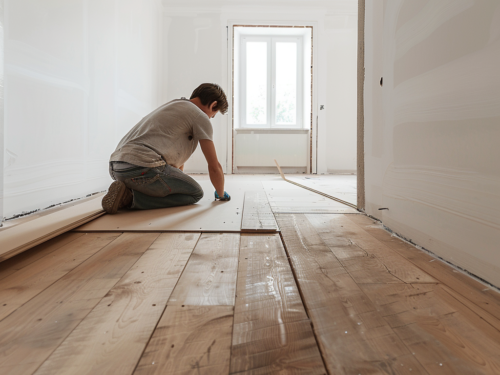
How to Measure Your Room for Hardwood Flooring
Are you thinking about getting beautiful new hardwood floors but not sure how much you’ll need to budget for? If so, you’ve come to the right place. Let’s break down the process for how to measure your room for hardwood flooring, including best practices and must-have tips.
Tools You Will Need
First, gather the tools you will need:
- A measuring tape (make sure it’s long enough to measure your rooms)
- A notepad and pen (or a smartphone) to write down your measurements
- A calculator to help with math
Drawing Your Room
Start by drawing a simple picture of your room on a piece of paper. It doesn’t need to be perfect! Just make sure to include all parts of the room, including closets and hallways if you plan to put flooring there too. Label each part of your drawing so you know what you are measuring.
Example of a Room Drawing
Here’s a simple example to guide you:
- Draw the Outline: Start by drawing the basic shape of your room. If it’s a rectangle, draw a rectangle. If it’s an L-shape, draw two connected rectangles.
- Add Features: Draw in the doors, windows, and any built-in furniture. Label these features.
- Divide Irregular Spaces: If your room isn’t a perfect shape, divide it into smaller rectangles.
Measuring the Length and Width
Now it’s time to measure the length and width of your room.
- Measure the Length:
- Place one end of the measuring tape at one wall.
- Extend the tape to the opposite wall.
- Write down the measurement in feet and inches on your drawing.
- Measure the Width:
- Place one end of the measuring tape at one side wall.
- Extend the tape to the opposite side wall.
- Write down the measurement in feet and inches on your drawing.
Example
If your room is 12 feet long and 10 feet wide, write down:
- Length: 12 feet
- Width: 10 feet
Best Practice: Use Graph Paper for Complex Layouts
For rooms with complex shapes or multiple sections, use graph paper to draw your room to scale. This makes it easier to visualize the space and calculate the square footage accurately. Each square on the graph paper can represent one square foot of your room.
Calculating the Square Footage
To know how much flooring you need, you must calculate the square footage of your room. Here’s how you do it:
- Multiply the Length by the Width:
- Use your calculator to multiply the length by the width.
- Example: 12 feet (length) × 10 feet (width) = 120 square feet
So, your room is 120 square feet.
Tip: Account for Floor Transitions
When measuring, remember to consider any transitions between different types of flooring, such as from hardwood to carpet or tile. Make a note of where these transitions will be and measure these areas carefully to ensure a smooth and professional-looking finish.
Measuring Irregular Spaces
If your room isn’t a perfect rectangle or square, you might have to break it down into smaller parts. For example, if your room is L-shaped, measure each section separately.
- Measure each section as if it were its own rectangle.
- Calculate the square footage for each section.
- Add the square footage of all sections together to get the total.
Example
If one part of your L-shaped room is 8 feet by 10 feet (80 square feet) and the other part is 4 feet by 5 feet (20 square feet), add them together:
- 80 square feet + 20 square feet = 100 square feet
Best Practice: Measure Twice, Cut Once
Always measure your room at least twice to ensure accuracy. If your two measurements don’t match, take a third measurement to confirm. This practice helps prevent mistakes and ensures you buy the correct amount of hardwood flooring.
Including Closets and Hallways
Don’t forget to measure closets and hallways if you plan to put hardwood flooring there too. Measure these areas the same way you measured your main room and add their square footage to your total.
Example
If your main room is 120 square feet, and your closet is 10 square feet:
- 120 square feet + 10 square feet = 130 square feet
Adding Extra for Waste
When installing hardwood floors, it’s smart to buy a little extra to cover mistakes or odd cuts. Add about 10% more to your total square footage.
- Calculate 10% of your total square footage:
- Example: 130 square feet × 0.10 = 13 square feet
- Add this to your total square footage:
- 130 square feet + 13 square feet = 143 square feet
So, you should buy 143 square feet of hardwood flooring.
Double-Check Your Measurements
Before you buy your flooring, it’s a good idea to measure again. Double-checking helps make sure you didn’t make any mistakes. Measure your length and width again and recalculate if needed.
Asking for Help
If you’re unsure about measuring your room or if your room has a tricky shape, you can ask the experts at Walk The Plank for help. They can measure your space for you and make sure you get the right amount of flooring.
Final Thoughts
Measuring your room correctly is the first step to getting beautiful new hardwood floors from Walk The Plank in Bakersfield. By following these simple steps, you can be sure you’re buying just the right amount of flooring for your home. If you have any questions or need help, the friendly team at Walk The Plank is always ready to assist you. Happy measuring, and enjoy your new hardwood floors!


